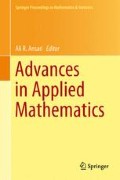Abstract
We are interested in the behavior of solutions for several stochastic differential equations such as Heston model. We focus on the numerical solutions via Milstein method for different stock market conditions. We examine the advantages and limitations of the model. Moreover, we introduce 3-dimensional matrix norms. Furthermore, we define market impression matrix norm as an application to the 3-dimensional matrix norms. Later, we perform simulations for various parameters.
Access this chapter
Tax calculation will be finalised at checkout
Purchases are for personal use only
References
Heston, S.: A Closed-form solution for options with stochastic volatility with applications to bond and currency options. Rev. Financ. Stud. 6(2), 327–343 (1993)
Kloeden, P.E., Platen, E., Schurz, H.: Numerical Solution of SDE Through Computer Experiments. Springer, Berlin (2003)
Milstein, G.N.: Approximate integration of stochastic differential equations. Theor. Prob. Appl. 19, 557–562 (1974)
Bodie, Z., Kane, A., Marcus, A.J.: Investments, 6th ed. Irwin McGraw-Hill, Boston, MA (2005)
Trefethen, L.N., Bau III, D.: Numerical Linear Algebra. SIAM, Philadelphia (1997)
Royden, H.L.: Real Analysis, 3rd edn. Macmillan, New York (1988)
Black, F., Scholes, M.: The pricing of options and corporate liabilities. J. Polit. Econ. 81(3), 637–654 (1973)
Cox, J.C., Ingersoll, J.E., Ross, S.A.: A Theory of the term structure of interest rates. Econometrica 53, 385–407 (1985)
Feller, W.: Two singular diffusion problems. Ann. Math. 54, 173–182 (1951)
Author information
Authors and Affiliations
Corresponding author
Editor information
Appendix
Appendix
1.1 Milstein Method
Definition.
Let \(\overline{y}_{N}\) be the numerical approximation to y(t N ) after N steps with constant stepsize \(h = (t_{N} - t_{0}/N)\); then \(\overline{y}\) is said to converge strongly to y with order p if \(\exists C > 0\) (independent of h) and δ > 0 such that
Lets consider the following SDEs:
Milstein method has the following form for equation (1):
Milstein method has strong order 1 for solving SDEs. Also Brownian motion \(\Delta W_{i}\) can be modeled as \(\Delta W_{i} = z_{i}\sqrt{\Delta t_{i}}\) where z i is chosen from N(0,1) standard normally random variable (see [3]).
1.2 Heston Model
In Heston’s stochastic volatility model the asset price process S t and the variance process v t : = σ t 2 solve the following two-dimensional stochastic differential equation (see [1]):
At the Black-Scholes-Merton (BSM) model (see [7]), the volatility σ was assumed to be constant. The main difference between BSM and Heston model is volatility behavior. It is stochastic and it satisfies mean-reverting property with a mean-reverting drift at the Heston model. The W 1andW 2 represent Brownian motions of asset price process and the variance process is correlated with correlation coefficient ρ ∈ [−1, 1]. Here ξ > 0 is the volatility parameter of the variance process, r ≥ 0 is the risk-free interest rate, q ≥ 0 is the dividend yield, κ > 0 is the rate of mean reversion, and θ > 0 is the long-run variance level (see [1]). Stochastic volatility model of Heston (1993) is frequently used. Heston’s model is derived from the CIR model of Cox, Ingersoll, and Ross (1985) for interest rates (see [8]). We choose the parameters as they satisfy the Feller condition 2κ θ ≥ ξ 2 at our simulations so that non-negativity of volatility can be guaranteed (see [9]).
Rights and permissions
Copyright information
© 2014 Springer International Publishing Switzerland
About this paper
Cite this paper
Duran, A., Izgi, B. (2014). Solution Behavior of Heston Model Using Impression Matrix Norm. In: Ansari, A. (eds) Advances in Applied Mathematics. Springer Proceedings in Mathematics & Statistics, vol 87. Springer, Cham. https://doi.org/10.1007/978-3-319-06923-4_20
Download citation
DOI: https://doi.org/10.1007/978-3-319-06923-4_20
Published:
Publisher Name: Springer, Cham
Print ISBN: 978-3-319-06922-7
Online ISBN: 978-3-319-06923-4
eBook Packages: Mathematics and StatisticsMathematics and Statistics (R0)

